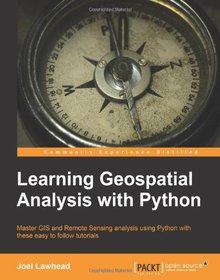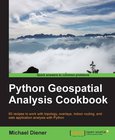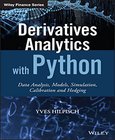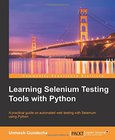Learning Geospatial Analysis with Python

Book Details:
| Publisher: | Packt Publishing |
| Series: | Packt , Learning |
| Author: | Joel Lawhead |
| Edition: | 1 |
| ISBN-10: | 1783281138 |
| ISBN-13: | 9781783281138 |
| Pages: | 364 |
| Published: | Oct 25 2013 |
| Posted: | Nov 19 2014 |
| Language: | English |
| Book format: | |
| Book size: | 12 MB |
Book Description:
Master GIS and Remote Sensing analysis using Python with these easy to follow tutorials Overview Construct applications for GIS development by exploiting Python Focuses on built-in Python modules and libraries compatible with the Python Packaging Index distribution system- no compiling of C libraries necessary This is a practical, hands-on tutorial that teaches you all about Geospatial analysis in Python In Detail Geospatial analysis is used in almost every field you can think of from medicine, to defense, to farming. It is an approach to use statistical analysis and other informational engineering to data which has a geographical or geospatial aspect. And this typically involves applications capable of geospatial display and processing to get a compiled and useful data. "Learning Geospatial Analysis with Python" uses the expressive and powerful Python programming language to guide you through geographic information systems, remote sensing, topography, and more. It explains how to use a framework in order to approach Geospatial analysis effectively, but on your own terms. "Learning Geospatial Analysis with Python" starts with a background of the field, a survey of the techniques and technology used, and then splits the field into its component speciality areas: GIS, remote sensing, elevation data, advanced modelling, and real-time data. This book will teach you everything there is to know, from using a particular software package or API to using generic algorithms that can be applied to Geospatial analysis. This book focuses on pure Python whenever possible to minimize compiling platform-dependent binaries, so that you don't become bogged down in just getting ready to do analysis. "Learning Geospatial Analysis with Python" will round out your technical library with handy recipes and a good understanding of a field that supplements many a modern day human endeavors. What you will learn from this book Automate Geospatial analysis workflows using Python Code the simplest possible GIS in 60 lines of Python Mold thematic maps with Python tools Get a hold of the various forms the geospatial data comes in Produce elevation contours using Python tools Create flood inundation models Learn Real-Time Data tracking and apply it in storm chasing Approach This is a tutorial-style book that helps you to perform Geospatial and GIS analysis with Python and its tools/libraries. This book will first introduce various Python-related tools/packages in the initial chapters before moving towards practical usage, examples, and implementation in specialized kinds of Geospatial data analysis. Who this book is written for This book is for anyone who wants to understand digital mapping and analysis and who uses Python or another scripting language for automation or crunching data manually.This book primarily targets Python developers, researchers, and analysts who want to perform Geospatial, modeling, and GIS analysis with Python.
Download Link:
Related Books:
Python Geospatial Analysis Cookbook
Over 60 recipes to work with topology, overlays, indoor routing, and web application analysis with Python About This Book * Explore the practical process of using geospatial analysis to solve simple to complex problems with reusable recipes * Concise step-by-step instructions to teach you about projections, vector, raster, overlay, indoor routing and topology analysis * Create a basic indoor routing application with geodjango Who This Book Is For If you are a student, teacher, programmer, geospatial or IT administrator, GIS analyst, researcher, or scientist looking to do spatial analysis, then this book is for you. Anyone trying to answer simple to complex spatial analysis questions will get a working demonstration of the power of Python with rea...
Derivatives Analytics with Python
Data Analysis, Models, Simulation, Calibration and Hedging
Supercharge options analytics and hedging using the power of Python Derivatives Analytics with Python shows you how to implement marketconsistent valuation and hedging approaches using advanced financial models, efficient numerical techniques, and the powerful capabilities of the Python programming language. This unique guide offers detailed explanations of all theory, methods, and processes, giving you the background and tools necessary to value stock index options from a sound foundation. Youll find and use selfcontained Python scripts and modules and learn how to apply Python to advanced data and derivatives analytics as you benefit from the 5,000+ lines of code that are provided to help you reproduce the results and graphics presented. Coverage ...
Learning Selenium Testing Tools with Python
A practical guide on automated web testing with Selenium using Python About This BookWrite and automate tests for your applications with SeleniumExplore the Selenium WebDriver API for easy implementations of small to complex operations on browsers and web applicationsPacked with easy and practical examples that get you started with Selenium WebDriverWho This Book Is ForIf you are a quality testing professional, or a software or web application developer looking to create automation test scripts for your web applications, with an interest in Python, then this is the perfect guide for you. Python developers who need to do Selenium testing need not learn Java, as they can directly use Selenium for testing with this book. In Detail Selenium WebDriver is ...
2007 - 2021 © eBooks-IT.org



